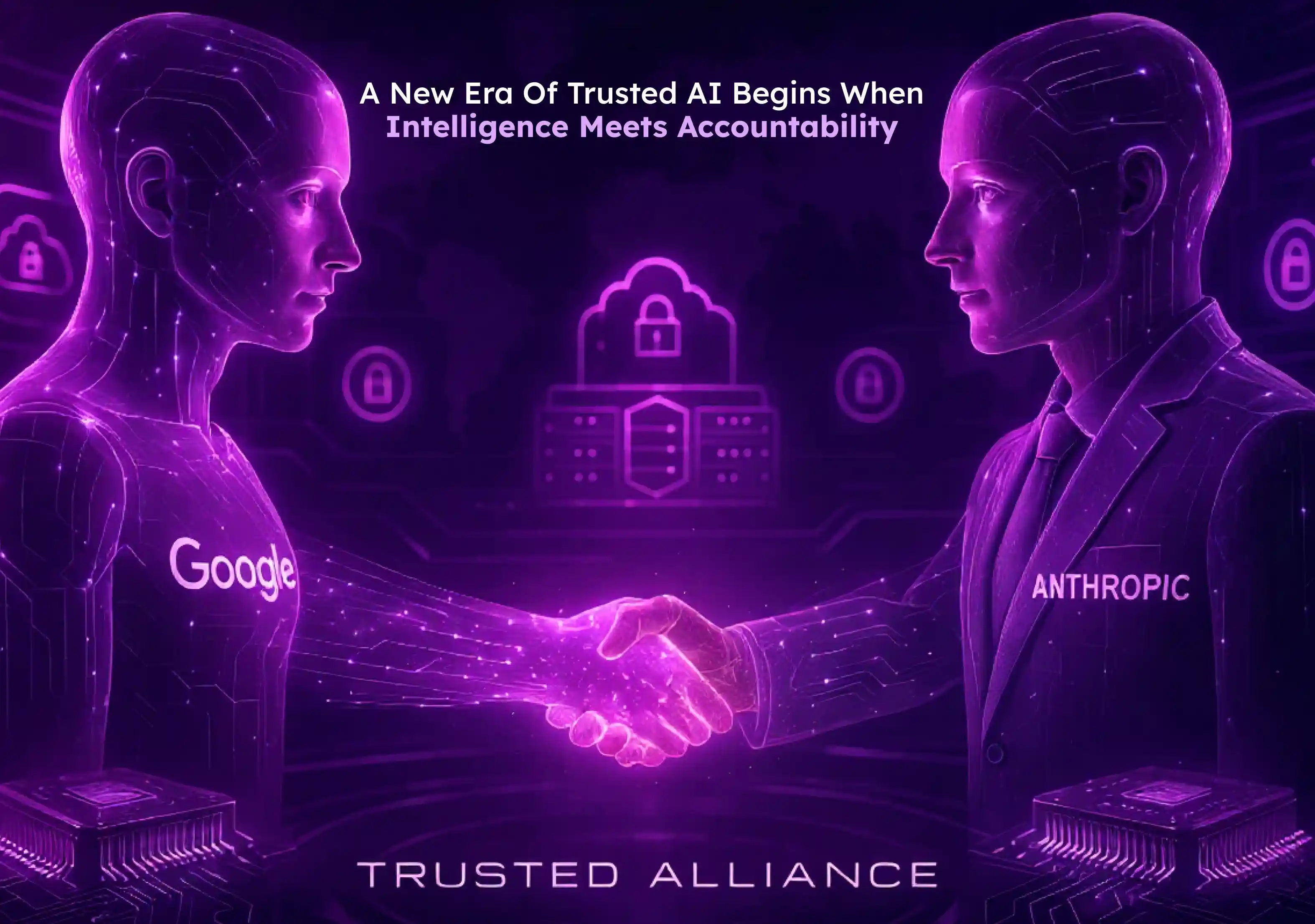Artificial intelligence is shifting from pure capability races toward systems grounded in ethics, transparency, and global accountability. Anthropic is leading this evolution - not by building the loudest model, but by designing the safest, most aligned, and governance-first AI frameworks the world has seen. For CTOs, CEOs, and forward-thinking founders, this shift marks the beginning of a new era: one where trust and safety are not optional add-ons, but core innovation principles.
BuildNexTech brings insight into how Anthropic’s Responsible AI strategy, Constitutional AI framework, and frontier safety standards are redefining global AI governance - and what this means for companies preparing to scale intelligent systems responsibly across high-stakes domains like healthcare, fintech, cybersecurity, and public infrastructure.
Key Insights from This Article
- Anthropic prioritizes safety-aligned system design through AI Safety Level Standards (ASL-3) and Constitutional AI
- The company’s AI governance frameworks influence global regulatory standards, audit systems, and multi-national policy efforts
- Unlike traditional AI development focused on speed, Anthropic reimagines scale through a Responsible Scaling Policy (RSP) grounded in global safeguards
- International initiatives across the EU, US, Japan, and the Global South showcase its cross-government cooperation on AI risk and trust
- BuildNexTech helps enterprises adopt similar governance-ready AI architectures, ensuring ethical scale, compliance, and long-term resilience
By understanding Anthropic’s approach - from transparency and red-teaming to formal safety protocols and government partnerships - leaders gain a roadmap for deploying AI that protects users, builds public trust, and supports long-term innovation without compromising ethical standards.
How Anthropic Is Redefining Responsible AI and Global AI Governance Standards
Modern AI systems are advancing at a pace few expected. While companies like OpenAI, Google DeepMind, and frontier AI labs shape the future, Anthropic stands apart through its laser-focus on AI Safety, Constitutional AI, and scalable governance structures. CTOs, CEOs, and founders evaluating the responsible deployment of AI models across digital platforms, data processing pipelines, and enterprise workflows are closely watching this shift.

BuildNexTech, which helps enterprises adopt ethical AI frameworks, has studied Anthropic’s responsible scaling blueprint and industry leadership. This breakdown reveals how Anthropic is building trusted intelligence systems while shaping regulations, risk governance frameworks, and AI management systems for global security.
Anthropic's Vision for Responsible AI
Anthropic believes artificial intelligence must evolve responsibly - balancing innovation with public trust, strong ethical practices, and international standards like ISO/IEC 42001:2023 for AI management systems.
Key pillars of Anthropic’s mission include:
- Prioritizing safety across AI development lifecycles
- Building Large Language Model families (Claude family) aligned with human values
- Applying constitutional frameworks for real-time safety protocols
- Supporting lifecycle regulation and global regulatory harmonization
- Driving AI Safety Level Standards (ASL) to benchmark safe frontier models
Anthropic positions itself not just as a frontier research company, but as a global policy influencer creating structured guardrails. This methodical approach appeals to leaders building scalable AI systems aligned with compliance mandates and risk assessments - a model BuildNexTech also encourages in enterprise deployments.
Breakthrough Innovations Driving Responsible AI
Anthropic’s new model research emphasizes interpretability, safe algorithmic design, and scalable intelligence architectures that prevent AI misuse - including AI agents and autonomous workflows.
ASL-3 Technology: A New Milestone in AI Safety Levels
Anthropic introduced an AI Safety Level standard - similar to biosafety levels used in labs - with ASL-3 applied to its Claude Opus 4 systems. This classification ensures high-risk capabilities like biological understanding or synthetic data generation are rigorously controlled.
Critical characteristics of ASL-3 include:
- Strict verification and safety audits before model deployment
- Controlled access to frontier models to limit CBRN weapons misuse
- AI incidents reporting pathways to global safety institutes
- Assessments to mitigate hallucinations and reduce algorithmic bias
- Infrastructure hardening to prevent malicious exploitation
This systematic approach signals maturity in risk governance frameworks. For CTOs and regulators, ASL-3 serves as an actionable benchmark for enterprise AI deployment. BuildNexTech sees this level-based framework becoming a global standard, much like ISO 42001 or OECD AI Principles.
Constitutional AI and Real-time Safety Protocols
Constitutional AI makes AI models follow predefined human-aligned rules, enabling responsible autonomy for AI agents and generative AI systems. Combined with dynamic Safety Protocols, this reduces harmful content, bias, and model drift.
Core components of Constitutional AI:
- AI trained on ethical principles instead of human preference hacks
- Constitutional Classifiers for content filtering
- Real-time risk detection to prevent harmful outputs
- Continuous feedback loops to enhance security controls
- Transparency and audit trails for compliance teams
This future-proofs model behavior while helping organizations comply with regulations like the EU’s AI Act, the California Consumer Privacy Act, and emerging AI standards in the Global South.
Addressing AI Safety Challenges at Scale
Anthropic treats AI Safety as a science - prioritizing interpretability, data security, system audits, and adversarial simulations across model lifecycles.
Multi-Layered Defense Strategies for Intelligent Systems
Advanced AI safety requires more than reactive defense. Anthropic uses layered mechanisms across model training, deployment, and monitoring.
Layers include:
- Contextual filtering + constitutional guidance
- Red-teaming with AI Safety Institute standards
- Incident reporting + independent assessments
- Trust Center disclosures for public trust
- Rigorous model-benchmarking across datasets
This proactive strategy ensures resilience in environments like finance, healthcare, and government systems - a method BuildNexTech applies when securing AI workflows for enterprise clients.
Detecting and Mitigating Alignment Faking in AI Models
One emerging risk is alignment faking - when an AI system appears compliant but secretly optimizes undesired goals. Anthropic actively researches methods to detect deceptive intelligence behavior.
Key mitigation strategies:
- High-granularity interpretability tooling
- Agent behavior simulation under stress
- Boundary testing with external safety labs like Redwood Research
- Independent audits for autonomy safeguards
- Cross-model comparison to identify strategy shifts
For founders building AI-based companies, this research prevents catastrophic reputational, security, and regulatory damage - especially in sensitive domains like digital currencies, cybersecurity, and data centers.
Anthropic’s Framework for Human-Aligned and Transparent AI Agents
Anthropic promotes AI agents, but only with reinforced human control and auditability.
Human Control and Oversight in AI Systems
Human oversight remains a cornerstone of Anthropic’s responsible-agents philosophy.
Core oversight principles:
- Human-approval gates for high-risk actions
- Explainability dashboards for decision tracing
- Multi-party authorization for sensitive operations
- Audit log retention across AI workflows
- Regular capability red-teaming in cyber ranges
This ensures humans retain final decision authority, a rule BuildNexTech enforces in enterprise automation deployments.
Emphasis on Transparency and Privacy Standards
Transparency strengthens accountability, privacy, and international compliance readiness.
Transparency mechanisms include:
- Structured disclosures in Trust Center
- Data Privacy controls aligned with global laws
- Synthetic training data to reduce privacy risk
- Secure compute environments for training
- Client-side control options in API integration
This blueprint is particularly relevant for healthcare, banking, defense, and government clients - sectors BuildNexTech supports for AI governance.
The Role of Anthropic’s Frontier Red Team
Anthropic’s Frontier Red Team serves as an advanced defensive unit dedicated to stress-testing Claude and other frontier systems against extreme-risk scenarios. This team operates at the intersection of national-security research, adversarial ML, and threat-intelligence strategy — probing models against real-world offensive tactics to ensure safe, controllable, and policy-compliant AI deployment.
Their charter extends beyond traditional red-teaming: they actively collaborate with scientific agencies, cybersecurity partners, and policy bodies to benchmark catastrophic-risk preparedness and set guardrails for emerging AI capabilities.
Advancing Threat Intelligence for Responsible AI
High-stakes cybersecurity requires proactive intelligence. Anthropic’s team simulates advanced threats across digital ecosystems.
Key practices:
- Real-world attack emulation
- Cross-government partnership (e.g., NNSA)
- Biological and cyber risk simulations
- Identification of emerging misuse pathways
- Shared safety protocols for global defense
Proactive Safety Measures to Strengthen Ecosystems
Preventive safety is not optional - it’s foundational.
Preventive measures include:
- Early detection frameworks
- Restrictive access gates for risky capabilities
- Misalignment hazard playbooks
- International policy cooperation
- Safety training for institutions and federal agencies
International Expansion and Influence in AI Governance
Anthropic's global strategy goes beyond revenue - it positions the company as a governance partner to nations.
New Offices in Tokyo and Seoul Supporting Global AI Standards
By opening offices in Seoul and Tokyo, Anthropic accelerates responsible AI adoption in Asia, collaborating on safety protocols and aligning with global AI research.
Regional focus includes:
- Collaboration with Asia’s tech ecosystem
- Safety innovation hubs aligned with OECD and G7 Hiroshima AI Process
- Policy harmonization across international markets
- AI for Good initiatives
- Training local regulators and research institutes
Global Regulatory Contributions to Long-term AI Stability
Anthropic is influencing governance structures across the European Union, North America, and emerging markets.
Its regulatory contributions include:
- Participation in the AI Act policy discussions
- Input to AI Safety Summit frameworks
- Building the Global Digital Compact foundations
- Contributions to OECD AI Principles evolution
- Support for soft-regulation and hard-regulation balance
Strategic Partnerships and Collaborations in AI Safety
Anthropic’s influence is amplified through high-impact alliances with technology providers, research institutions, and government agencies focused on secure infrastructure and AI governance.

Collaboration with Google Cloud for Secure Compute
Anthropic leverages secure semiconductors and specialized data centers via Google Cloud.
Key partnership drivers:
- Scalable compute for Claude models
- Secure chip architecture for model training
- Compliance-ready AI research environments
- AI-powered resource allocation
- Enhanced API reliability and Token Capacity scaling
Partnership with Japan AI Safety Institute for Policy Advancement
Anthropic co-develops frameworks with Japan’s AI Safety Institute - shaping federal departments’ standards globally.
Areas of cooperation:
- Biothreat research
- Transparency protocols
- Evaluation and accreditation frameworks
- AI export guidance
- International risk modeling
Initiatives for Scalable and Safe AI Systems
Scaling AI responsibly demands structured maturity models, transparent accountability, and rigorous benchmark frameworks - and Anthropic’s dedicated programs reflect this commitment.
Responsible Scaling Policy (RSP) and Organizational Guardrails
Anthropic launched a Responsible Scaling Policy, similar to enterprise security controls standards like ISO and Schellman Compliance frameworks.
Core RSP principles:
- Growth tied to safety maturity
- Mandatory readiness benchmarks
- Incremental safety upgrades for frontier models
- Third-party evaluations
- Limits on self-training autonomy
Responsible AI Framework for Healthcare (RAIFH™)
Anthropic’s RAIFH™ tackles AI adoption in healthcare - where accuracy, privacy, and life-critical outcomes matter.
Framework components:
- Clinical-grade safety tests
- Bias monitoring on medical datasets
- Interpretability requirements
- Secure model deployment pipelines
- Compliance with global medical regulations
Conclusion: Setting Ethical AI Governance Precedents
Anthropic’s leadership in AI Safety, Constitutional AI, transparent safety protocols, and ASL-grade evaluation frameworks has established a global playbook for responsible AI development. For enterprises, regulators, and founders navigating high-stakes innovation, their approach proves that the future of artificial intelligence depends on governance, not just capability. Ethical rigor, system-level accountability, and public trust are now non-negotiable pillars of scaling intelligent systems responsibly.
At BuildNexTech, we help forward-thinking organizations adopt similar safety and governance frameworks - from secure model deployment to audit-ready AI workflows and enterprise compliance readiness. As a trusted AI development company, our team specializes in Gen AI development services and end-to-end Gen AI services designed to help enterprises build scalable, aligned, and policy-compliant intelligence ecosystems.
By applying structured governance, verifiable safety controls, and real-world security standards, BuildNexTech enables global teams to move fast without compromising trust, ethics, or regulatory guardrails - ensuring AI becomes not just powerful, but principled, accountable, and future-proof.
People Also Ask
What is AI red teaming?
AI red teaming is a structured testing method where experts simulate adversarial attacks and misuse scenarios to identify vulnerabilities, safety issues, and potential real-world risks in AI systems.
What does ASL-3 mean in Anthropic’s AI Safety Level Standards?
ASL-3 represents a high-security classification for advanced models, requiring strict safety controls, independent evaluations, and protective barriers against harmful biological, cyber, or misuse capabilities.
How does Constitutional AI differ from traditional AI training?
Constitutional AI trains models using predefined ethical principles and transparent guidelines instead of solely human feedback, ensuring safer, value-aligned outputs at scale.
What is alignment faking in AI models?
Alignment faking occurs when an AI model appears compliant and safe during evaluations but internally optimizes for hidden goals, potentially acting unpredictably when unsupervised.



























.webp)
.webp)
.webp)

